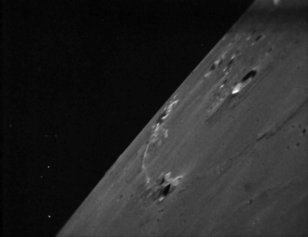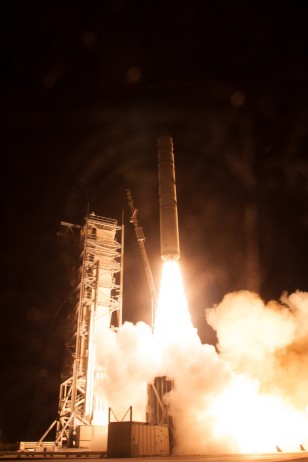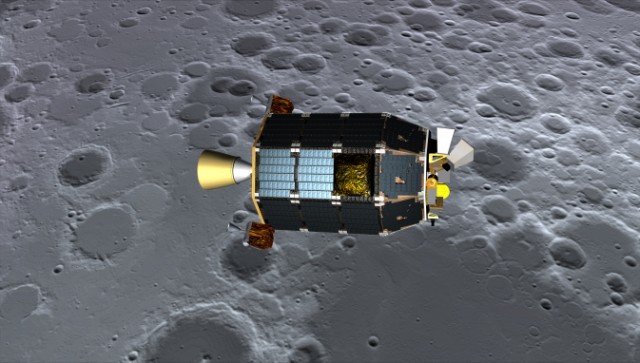NASA’s Lunar Atmosphere and Dust Environment Explorer, or LADEE mission had a smashing ending early Friday morning when the US space agency crashed the spacecraft into the moon’s surface.
The ground controllers, monitoring the spacecraft’s operations from NASA’s Ames Research Center in Moffett Field, California, confirmed that it impacted the lunar surface as planned sometime between 2130 and 2222 UTC on Friday (4/18/14).

One of the final images taken by LADEE, as it orbits the moon, shows a minor lunar mountain range, Montes Agricola and the flat-floored crater Raman. (NASA Ames)
Mission officials said that LADEE didn’t have enough fuel to remain in an ongoing lunar orbit or sustain its science operations. And, since the spacecraft’s orbit was already naturally decaying following the mission’s final science phase earlier this month, it was decided that it would be intentionally sent down onto the lunar surface.
Flying at less than 2 kilometers above the lunar surface, LADEE mission specialists said that the final science phase allowed them to gather some very unique measurements.
NASA said that as it impacted the moon, the vending machine-sized LADEE spacecraft heated up several hundred degrees and broke apart or vaporized. The space agency believes that if any material remained after crashing, it’s likely buried in the moon’s shallow craters.
“At the time of impact, LADEE was traveling at a speed of 3,600 miles per hour – about three times the speed of a high-powered rifle bullet,” said Rick Elphic, LADEE project scientist at Ames. “There’s nothing gentle about impact at these speeds – it’s just a question of whether LADEE made a localized craterlet on a hillside or scattered debris across a flat area. It will be interesting to see what kind of feature LADEE has created.”

A Minotaur V rocket carrying the Lunar Atmosphere and Dust Environment Explorer lifts off from NASA’s Wallops Flight Facility in Virginia on Friday, Sept. 6, 2013. (NASA/Chris Perry)
LADEE was launched from NASA’s Wallops Flight Facility in Virginia on September 7, 2013 from NASA’s Wallops Flight Facility in Virginia. The spacecraft entered lunar orbit on October 6, 2013 and started to gather data on November 10, 2013. In January NASA decided to extend the LADEE mission by an extra month after it finished its very successful primary science phase which took place earlier this month (April 2014).
Throughout its mission LADEE was able to collect some very comprehensive information about the lunar atmosphere’s structure and composition.
NASA scientists continue to pore through the data gathered throughout the lunar spacecraft’s mission and are hoping that it will provide an answer to a question that has puzzled many since the Apollo moon missions of the late 1960’s early 1970’s. Was the pre-sunrise glow that was observed just above the moon’s horizon caused by lunar dust that had been electrically charged by sunlight?
Thousands of people from around the world shared in the final part of LADEE’s mission by taking part in a NASA sponsored internet contest called “Take the Plunge”. The contest challenged participants to guess the date and time the spacecraft would crash into the moon. Those who provided correct answers will win a digital congratulatory certificate.
“LADEE was a mission of firsts, achieving yet another first by successfully flying more than 100 orbits at extremely low altitudes,” said Joan Salute, LADEE program executive, at NASA Headquarters in Washington. “Although a risky decision, we’re already seeing evidence that the risk was worth taking.”
Video conception of LADEE’S final moments (NASA/Ames)





















Comments are closed.